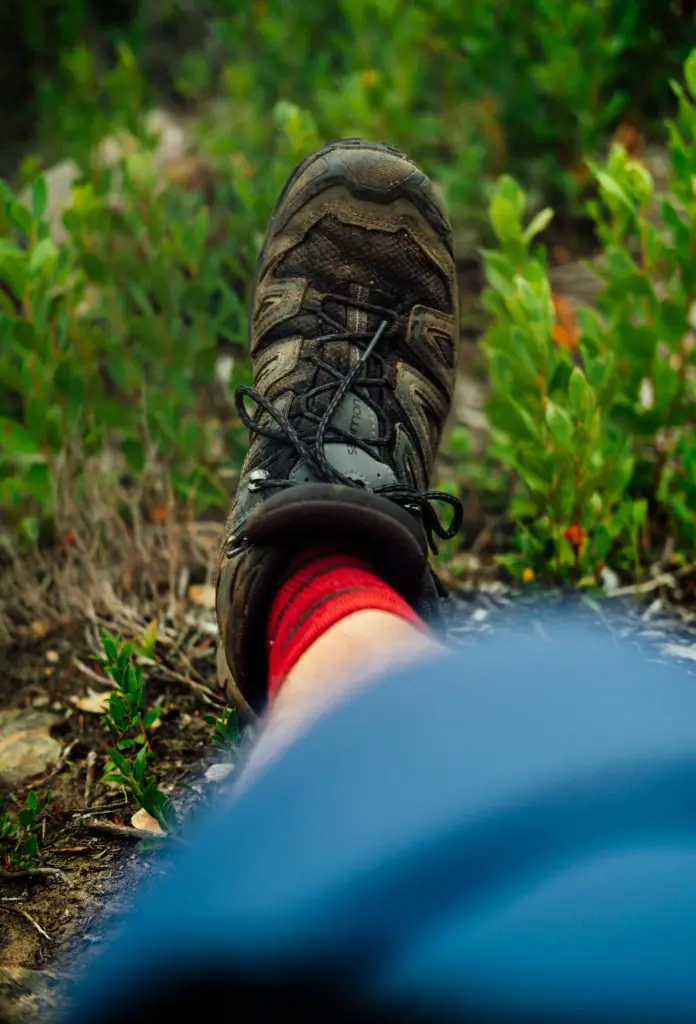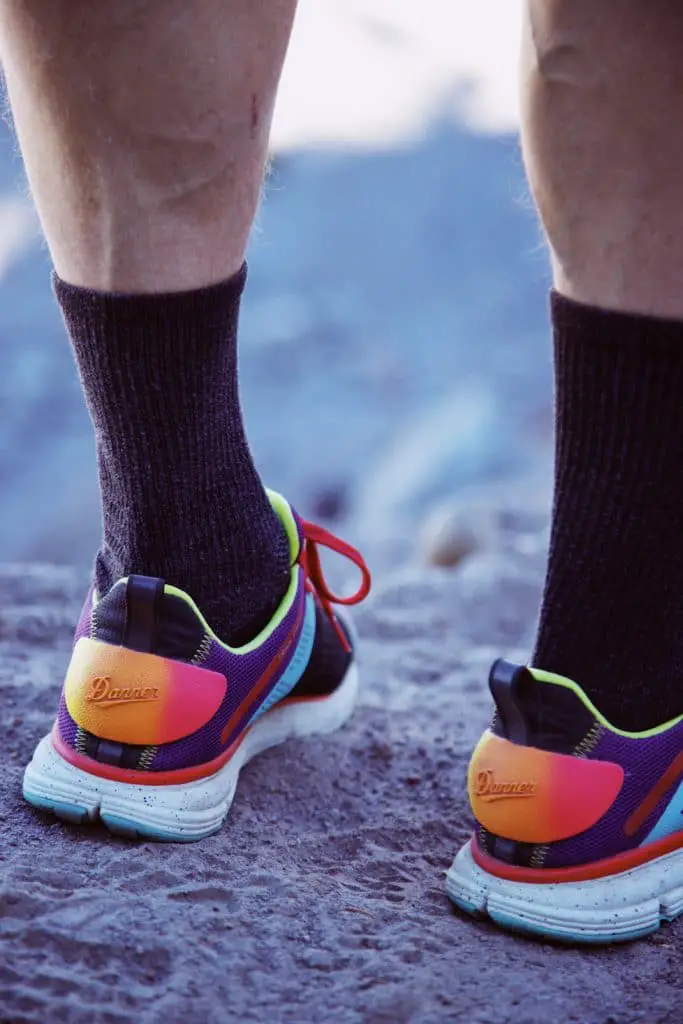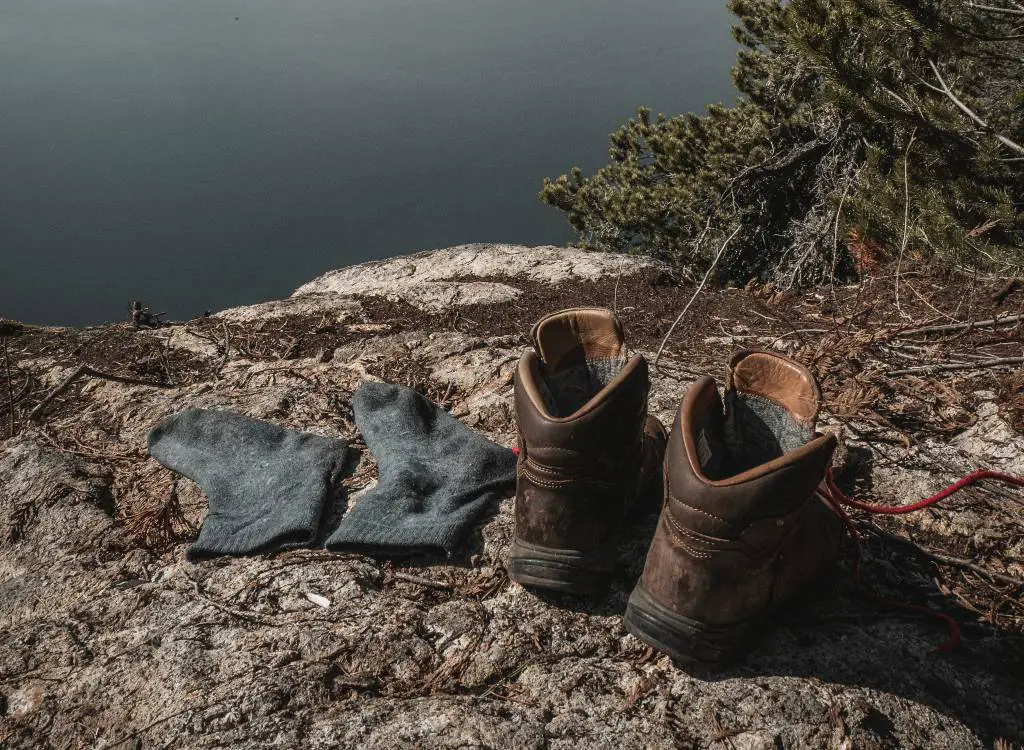Hiking is one of the most strenuous tasks you can impose on your feet. Unlike regular walking, in this situation, your feet go through extreme conditions, and keeping them protected is essential. While the primary protection from the outside is the boots, the socks are the piece of fabric between the inside of the boot and your foot.
Many inexperienced people don’t put too much thought into that fabric and usually get the cheapest ones they can buy. For some situations, that may not be a problem, but for others, like hiking, you should avoid them at any cost.
Even though cotton socks are among the cheapest ones you can buy, there are several reasons why you shouldn’t. Today, I’ll outline all the negative sides of cotton socks for hiking and include several recommendations. All 4 reasons are intertwined, so one of them can lead to another.
Reasons to Avoid Cotton Socks for Hiking

Moisture Absorption
People that have been hiking at least once know that moisture is their biggest enemy. While your boots may help you keep moisture and water away from your feet, they won’t do much regarding inner moisture – sweat.
During strenuous walking and climbing, your feet start to sweat, leading to one of the biggest cotton socks problems. Cotton is a material known for its moisture-absorbing properties, something you’d want to avoid when hiking. As a material, cotton can absorb over 2500% of its weight, making them the worst material to have on your feet. In comparison, synthetic fabrics like polyester can absorb moisture less than 1% of their weight.
The biggest problem in this situation is in colder temperatures. As tour feet sweat, all that moisture gets absorbed in the cotton, which will remain there. Keeping your feet cold is not a good idea and may even lead to hypothermia, an aspect closely linked to temperature regulation.
Temperature Regulation
In extreme situations, one of the most important jobs for socks is to regulate the temperature.
During hotter temperatures, it is essential for your feet to stay cool to avoid excessive sweating. On the other side, in colder climates, you’d want socks that can keep your feet warm.
Unlike some of the other materials, cotton is the worst one for this application. Water’s thermal conductivity is greater than the one of air, meaning that it can transfer temperatures from one side to another much faster. The temperature regulation properties can be linked to the moisture absorption than cotton has. In warmer climates, you may not have an issue with that, but your feet may freeze if the temperatures start to decline. To be honest, it’s a figure of speech, and you won’t see your feet become popsicles, but the temperature will definitely be lower than desired.
Regardless of how warm your boots are, they are not airtight, and after a certain amount of time, the temperature in your feet will start to decline.

Drying
During hiking, it is essential to have socks that you can dry off fairly quickly. Naturally, you won’t be able to do that in 5 minutes, but you also wouldn’t want to wait for hours to dry them.
Considering how much moisture cotton socks can absorb, you shouldn’t expect to have them dry as quickly as synthetic socks.
The longer your socks dry, the more exposed your feet are to the moist and unregulated temperature.
Weight
The last negative side of using cotton socks for hiking is the weight. When dry, they don’t weigh too much, at least not enough to feel like you have weights attached to your boots. Once the cotton starts soaking up moist from your feet, that’s when things can get problematic. Since cotton is so good at absorption, it can suck up moisture well over 2500% of its weight. You will start to feel that after several hours of hiking with cotton socks.
Our Recommendation
Considering how lousy cotton socks are for hiking, I will throw in a few recommendations of what to look out for. I already made a list of the best socks for boots, so you should check that out.
In general, the only rule when it comes to getting socks for hiking is to avoid cotton ones at any cost. With that said, you may ask yourself, which material is the best?
There isn’t a straight answer. All materials have pros and cons, and deciding which one to go for is up to you and your needs. If you are looking for a natural material alternative to cotton, wool is your best option. While it’s not the best approach for hiking socks, it doesn’t absorb as much moisture and dries much faster. The wicking isn’t the best, and they may turn out to be problematic in a hotter climate; they are a much better option than cotton socks.
Another natural option that seems to be getting quite a lot of attention recently is cocona. These socks are made from cocona fabric, which is a product of coconut shells. The result is socks that provide durability and quick drying properties.
Synthetic materials are considered the best in the business as they offer quite a lot of advantages, even over wool socks. The moisture absorption is almost minimal, meaning that there is hardly anything to dry. You also get excellent breathing properties while keeping your feet’s temperature well regulated.
Polyester is the most common one and usually comes in a combination with wool. This blend has the best wicking properties and enables your feet to breathe better.
Spandex is also a great option if you are looking for something with a bit more elasticity. Unlike other materials, these won’t lose their shape over time and are pretty good at avoiding wrinkling and bunching up.
If you want the most durable socks for hiking, then nylon is the best option. Out of all synthetic materials found in socks, these will be the longest-lasting ones, regardless of how much you wear and wash them.
Frequently Asked Questions
Should I avoid cotton socks entirely?
No. While I wouldn’t recommend cotton socks for hiking, that goes for socks that are 100% cotton. In recent years, the manufacturers have made good combinations of fabrics, like cotton and some synthetic ones. As a result, you get socks with low moisture absorption and quick drying properties. It is essential to know how much cotton content is in the fabric. The closer you get to 100%, the more of the cotton’s drawbacks you’ll start to notice. At the end of the day, I would avoid any kind of cotton for hiking socks, while for everyday use, you will be fine with some cotton on your feet.
What is the best material for hiking socks?
There isn’t the best and the worst; there is the material best suits your needs. To avoid feet odor, wool is an excellent option even after very prolonged use. It is also antibacterial; in case you have that kind of a problem with your feet. If you are looking for socks that absorb almost no moisture, keep the feet breathing and dry very quickly, then materials like polyester are an excellent choice.
Any purchasing recommendations for hiking boots and socks combinations?
In general, boots and socks shouldn’t be linked together, as there is no correlation between them. Get the boots and socks that you feel will be the most comfortable. With that said, there are a few recommendations.
Your socks and boots must be the exact size of your feet, meaning that you shouldn’t go over or less than that. By doing so, you will ensure that the boots and socks will be a snug fit and will be able to perform optimally. When purchasing, there is only one thing to keep in mind when pairing boots and socks, and that is the height. You should always get socks that are higher than the boots. That way, the socks will be able to do their job of protecting your skin from the boot.

